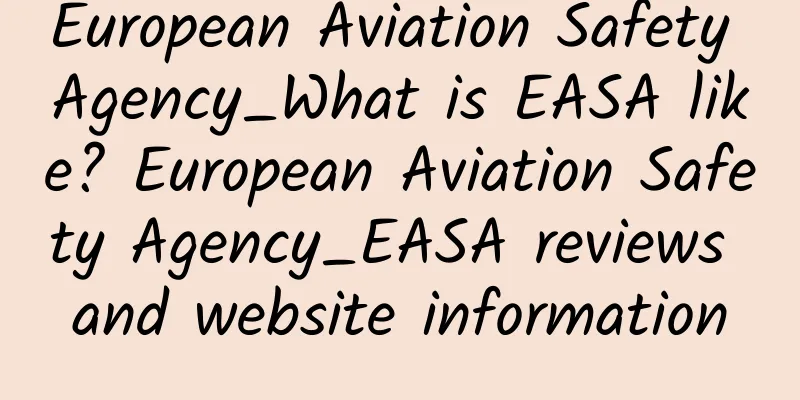European Aviation Safety Agency_What is EASA like? European Aviation Safety Agency_EASA reviews and website information

|
European Aviation Safety Agency_What is EASA? The European Aviation Safety Agency (EASA) is the world's main issuer of aircraft airworthiness certificates (the other is the Federal Aviation Administration of the United States). It was formally established in 2003 and is currently headquartered in Cologne, Germany. It is one of the EU agencies and is mainly responsible for drafting civil aviation safety regulations and executing operational certification work related to aviation safety. Website: www.easa.europa.eu European Aviation Safety Agency (EASA): Guardian of global aviation safetyIn today's increasingly globalized era, the aviation industry is an important link connecting the world, and its safety has always been a core issue of public concern. The European Aviation Safety Agency (EASA) is an authoritative agency established to meet this challenge. Since its official establishment in 2003, EASA has not only become the core force of aviation safety management within the EU, but also occupied a pivotal position in the field of global aviation safety. EASA is headquartered in Cologne, Germany. As an independent EU agency, its main responsibilities include formulating and implementing civil aviation safety regulations, supervising aircraft airworthiness certification, and coordinating aviation safety issues among member states. As one of the world's most important issuers of aircraft airworthiness certificates, EASA, together with the US Federal Aviation Administration (FAA), is responsible for ensuring global air transportation safety. This article will take a deep look at EASA’s role, history, core missions, and its contribution to global aviation safety. We will also explain how to access relevant resources and information through its official website ( www.easa.europa.eu ). EASA's history and developmentThe birth of EASA was not achieved overnight, but rather a long process of gestation and evolution. As early as the mid-20th century, with the rapid development of aviation technology and the surge in the number of cross-border flights, European countries gradually realized that aviation safety required a unified regulatory framework. However, due to the large differences in aviation management policies among countries at the time, it was particularly urgent to establish a safety regulatory system covering the whole of Europe. To solve this problem, in 1993, the European Commission proposed to set up an agency specifically responsible for aviation safety to replace the independent regulatory model previously dispersed among member states. After nearly ten years of efforts, the European Aviation Safety Agency was officially established on April 28, 2003, and began operations in July of the same year. The establishment of EASA marks a new stage in the EU's aviation safety management - from a single country-led to regional collaborative governance. In the subsequent development process, EASA has continuously expanded its scope of responsibilities and gradually included more types of aircraft in its regulatory scope. For example, in 2008, EASA's scope of authority was extended to the field of drones; in 2018, the new "Basic Regulation" came into effect, giving EASA greater power and responsibility, enabling it to perform aviation safety regulatory functions more comprehensively. These changes not only reflect the advancement of aviation technology, but also reflect EASA's keen insight into emerging aviation fields. Today, EASA has become a benchmark organization in the field of global aviation safety, and its influence goes far beyond the borders of the European Union. Both aircraft manufacturers and airlines must follow the standards and specifications set by EASA to obtain the qualification to enter the European market. This strict regulatory mechanism not only improves the overall safety of the European aviation industry, but also sets an example for global aviation safety. EASA's main responsibilities and tasksAs the core agency in the field of aviation safety in the European Union, EASA's responsibilities cover a number of key areas, aiming to ensure the safety and sustainable development of the aviation industry. The following are EASA's main tasks: 1. Formulate and implement aviation safety regulationsAs the main executor of the EU's aviation safety policy, EASA is responsible for drafting and implementing a series of aviation safety regulations. These regulations cover all aspects from aircraft design, manufacturing to operation, ensuring that all aviation activities meet the highest safety standards. For example, the Airworthiness Directives issued by EASA specify in detail the operating requirements of aircraft in specific situations, thereby effectively reducing potential risks. In addition, EASA also regularly reviews and updates existing regulations to adapt to the development of new technologies and trends. This dynamic adjustment mechanism enables EASA to always maintain forward-looking control of aviation safety. 2. Issuance of aircraft airworthiness certificateThe airworthiness certificate is a prerequisite for the legal operation of an aircraft, and EASA is one of the main certification bodies in this field. EASA conducts a comprehensive assessment of the design, manufacture and testing of aircraft to ensure that they meet international standards and EU regulations. Only aircraft that have passed EASA's strict certification can obtain permission to fly within the EU. In addition to traditional commercial aircraft, EASA is also responsible for the airworthiness certification of other types of aircraft such as helicopters and drones. This comprehensive regulatory model ensures the safety of various types of aircraft and also promotes the healthy development of emerging aviation technologies. 3. Supervision and inspection of aviation activitiesTo ensure the effective implementation of the regulations, EASA has established a comprehensive supervision and inspection mechanism. The agency dispatches professional teams to conduct regular or irregular inspections of airlines, maintenance facilities and airports to promptly identify and correct potential safety hazards. In addition, EASA also works closely with EU member states and other international organizations to carry out cross-border inspections. This collaborative mechanism not only enhances regulatory effectiveness, but also promotes the unification of global aviation safety standards. 4. Provide technical support and trainingEASA is not only a maker of regulations, but also a provider of technical support and training services. The agency helps aviation practitioners improve their skills and better understand and comply with relevant regulations by holding seminars, publishing technical guidelines and providing online learning resources. For example, EASA's official website ( www.easa.europa.eu ) provides a wealth of training materials and technical documents for users to access and download at any time. This open sharing attitude further consolidates EASA's position as a global aviation safety knowledge center. EASA's role in global aviation safetyAs one of the world's leading aviation safety regulators, EASA plays an indispensable role in global aviation safety. Through cooperation with other international organizations and national agencies, EASA not only promotes the unification of global aviation safety standards, but also actively participates in addressing various aviation safety challenges. 1. International cooperation and coordinationEASA maintains a close working relationship with the International Civil Aviation Organization (ICAO), the U.S. Federal Aviation Administration (FAA) and other regional aviation safety agencies. This international cooperation helps share best practices, coordinate regulatory policies and jointly address transnational aviation safety issues. For example, in the case of the grounding of the Boeing 737 MAX, EASA worked closely with the FAA and other national regulators to jointly assess the cause of the accident and develop a plan for resumption of flight. This collaborative action not only speeds up the resolution of the problem, but also enhances the public's confidence in aviation safety. 2. Addressing emerging aviation safety challengesWith the rapid development of drone technology, the field of aviation safety is facing many unprecedented challenges. To this end, EASA has taken the lead in developing the world's first comprehensive drone regulatory framework, clarifying the operational specifications and safety requirements of drones. In addition, EASA is actively researching and developing a new generation of aviation safety technologies, such as artificial intelligence-assisted decision-making systems and automated flight control systems. The application of these innovative technologies will further improve the safety and efficiency of the aviation industry. 3. Promote sustainable aviation developmentIn addition to focusing on aviation safety, EASA is also committed to promoting the sustainable development of the aviation industry. By formulating environmental regulations and supporting green technology innovation, EASA strives to reduce the impact of aviation activities on the environment. For example, EASA participates in the Clean Sky program, a large-scale research and development project funded by the European Union to develop more environmentally friendly aviation technologies and solutions. This forward-looking initiative reflects EASA's high regard for social and environmental responsibility. EASA official website: your gateway to aviation safety informationEASA's official website ( www.easa.europa.eu ) is an important platform for understanding the latest developments of the agency and obtaining information related to aviation safety. The website has rich and diverse content, covering regulatory documents, technical guidelines, news announcements, training resources and other aspects. For aviation practitioners, the "Regulations and Standards" section on the website is particularly important. This section lists in detail various regulations and guidance documents issued by EASA, including airworthiness directives, operating specifications and design standards. Users can quickly find the information they need through the keyword search function, which greatly facilitates the review and application of regulations. In addition, the website also has a "Data and Statistics" column, which provides various statistics and analysis reports on aviation safety. These data not only help to understand the current aviation safety situation, but also provide a reference for future policy making. For the general public, the EASA official website also provides a lot of easy-to-understand content, such as aviation safety basics, FAQs, and safety tips, etc. Through these contents, the public can better understand the importance of aviation safety and master the necessary safety knowledge. Conclusion: EASA - Pioneer in Future Aviation SafetySince its establishment, the European Aviation Safety Agency (EASA) has been committed to ensuring aviation safety, promoting technological innovation and promoting sustainable development. As a leader in global aviation safety, EASA not only provides solid support for the EU aviation industry, but also makes important contributions to the improvement of global aviation safety standards. In the future, as aviation technology continues to develop and new challenges emerge, EASA will continue to play its important role and lead global aviation safety to a higher level. Whether you are an aviation practitioner or a general public, you can visit the EASA official website ( www.easa.europa.eu ) to learn more about the work of this important organization and its profound impact on aviation safety. |
<<: How is Indian Railways? Indian Railways Reviews and Website Information
Recommend
What is taro stem? What are the effects and methods of taro stem?
You may think that taro stem is a kind of taro wh...
How to pickle salted Spanish mackerel? How to pickle salted Spanish mackerel?
Many people have eaten salted Spanish mackerel. I...
How is Google? Google reviews and website information
What kind of website is Google? Google is currentl...
What to eat when you often stay up late
For people in modern life, staying up late has be...
Fig Nutrition Analysis Fig Walnut Chiffon Recipe
Everyone knows that figs are delicious fruits, bu...
The efficacy and function of cucumber seeds
Cucumber is a vegetable that everyone is very fam...
Buckwheat porridge
I believe that few people have heard of buckwheat...
What is The News Trust like? Reviews and website information
What is the website of The News Letter? The News L...
Is white seed watermelon ripened artificially? What are the hazards of ripening watermelon artificially?
The arrival of summer has also boosted the enthus...
What can’t be eaten with straw mushrooms? What can’t be eaten with straw mushrooms?
Straw mushrooms are the most common edible fungi ...
How is the Vanuatu Tourism Bureau? Vanuatu Tourism Bureau reviews and website information
What is the website of Vanuatu Tourism Bureau? Van...
How is the German Consulate General in Chengdu? German Consulate General in Chengdu reviews and website information
What is the website of the Consulate General of Ge...
What is Zehus like? Zehus review and website information
What is Zehus? Zehus is a world-renowned high-tech...
How to grow Euphorbia obesa? Tutorial on cultivation techniques of Euphorbia obesa
Although the appearance of the Euphorbia panicula...
How to make winter melon and pork ribs soup
Winter is here, and it is another season of cold ...









